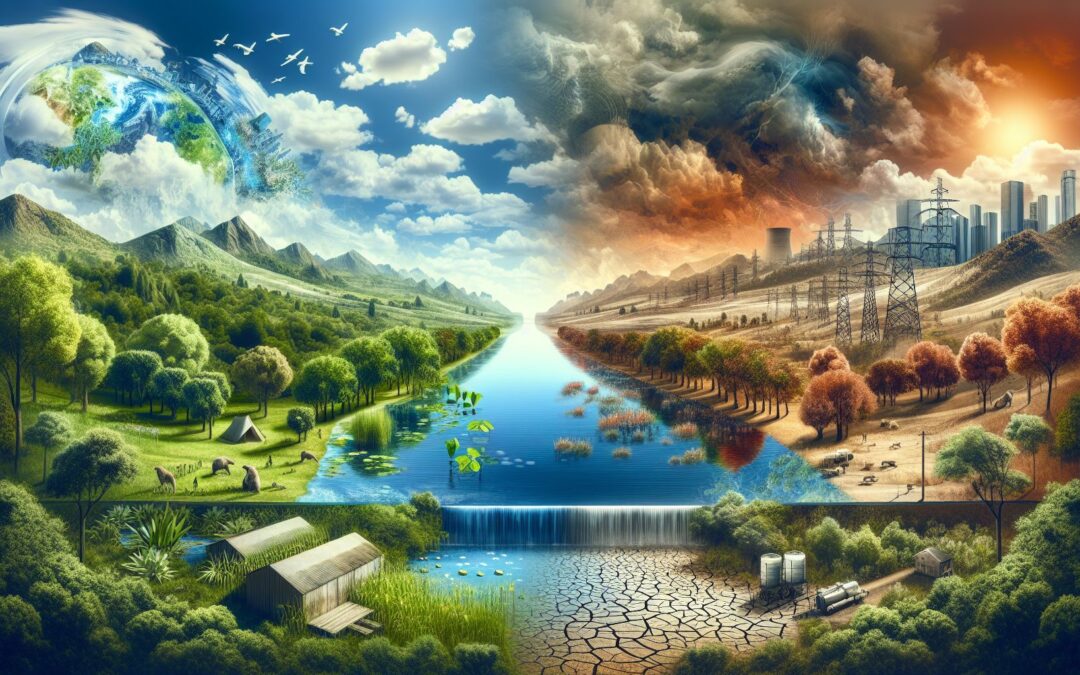As we delve deeper into the 21st century, one thing has become abundantly clear; the world is changing, and it’s changing fast. No element of life on earth is immune to these changes, and that applies to our water systems too. Our planet’s natural water cycle is seeing momentous shifts due to global warming and climate change. These changes are having a profound impact on water availability, quality, and predictability. The goal of climate change adaptation is to tackle these challenges head-on and make sure our planet remains liveable for future generations.
Understanding The Issue
Climate change is caused by an excessive amount of greenhouse gases in the Earth’s atmosphere. These gases trap heat, causing the overall global temperature to rise—a phenomenon known as global warming[^1^]. This rise in temperature disrupts the natural water cycle. It leads to more frequent and severe weather events, including floods, droughts, and storms.
Also, melting ice caps and glaciers due to rising temperatures lead to rising sea levels that can contaminate freshwater sources with saltwater. This phenomenon is known as saltwater intrusion. Moreover, higher temperatures lead to higher evaporation rates, causing more dry and arid conditions, leading to droughts in many regions of the world.
Climate change also puts immense stress on existing water infrastructure, designed and built under past climate conditions. Most infrastructures such as dams, levees, and canals may not be able to cope with the increased stress of changing rainfall patterns, increased flooding, or rising sea levels.
[^1^]: NASA’s Global Climate Change
The Necessity of Adaptation
Water-related challenges posed by climate change cannot be understated. They threaten not just our environment but our economies, health, and social well-being. Further, water plays an integral part in many vital sectors like agriculture, power, and manufacturing. Disruption to water availability and predictability caused by climate change threatens to shake the entirety of human society to its core.
Adaptation strategies are measures aimed at reducing vulnerability and enhancing resilience in the face of impending changes. Building adaptive capacity for water resources means developing the flexibility to manage current climate variability and future climate change impacts. Climatic unpredictability can be prepared for by generating a deep understanding of potential risks and developing strategies to manage these risks. This may involve infrastructure improvements, changes in management strategies, policy changes, and human behavioral changes.
Effective Climate Change Adaptation Strategies
Adaptation strategies to climate change in the context of water revolve around three essential categories – hard adaptation, soft adaptation, and ‘no regrets’ adaptation.
Hard Adaptation actions involve infrastructural changes. These are the physical alterations that aim to protect water resources and reduce the impact of detrimental climate conditions. This may involve the construction of seawalls or dikes against rising sea levels, building re-designed, resilient dams and levees capable of withstanding more frequent and severe floods[^2^].
Soft Adaptation measures involve policy changes, behavioral changes, and improved planning and education. This could include anything from policy reforms that promote water conservation, improving early warning systems for severe weather events, educating communities about their water footprint, or developing crisis management plans.
Lastly, ‘No Regrets‘ adaptation refers to actions that provide benefits whether or not the impacts of climate change are as severe as predicted. These include improving water efficiency, investing in green infrastructure like rain gardens and green roofs, installing rainwater harvesting systems, and reforesting watersheds.
[^2^]: Adapting to Climate Change
The Challanges Ahead
Climate change adaptation in the context of water is not without challenges. Financial constraints, disagreements between various stakeholders, technical limitations, and barriers to policy changes are all hurdles that need addressing.
Moreover, developing countries that already struggle with water security are disproportionately burdened by the impacts of climate change. These countries may lack the resources, infrastructures, and funds to implement effective adaptation strategies. International cooperation, financial aid, technology transfer, and knowledge exchange are essential to equipping such countries for adapting to climate change.
Conclusion
Water and climate change adaptation is one of the most complex and urgent issues humanity faces today. It’s a challenge that we all need to face together, at an individual, community, governmental, and international level. The task may be daunting, but with the right policies, strategies, and a collective will to change, we stand a fighting chance against the uncertainties that lie ahead.
Building resilience to climate change in our water systems is not just about preserving the resources we have now—it’s about ensuring a sustainable and vibrant world for generations to come. Water is not simply a resource; it’s the lifeblood of our planet. And it’s upon us to protect it.

